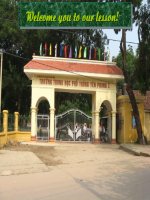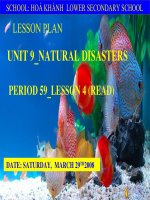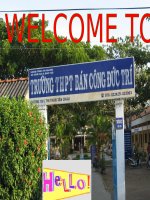unit 9 E9 READ
Bạn đang xem bản rút gọn của tài liệu. Xem và tải ngay bản đầy đủ của tài liệu tại đây (3.22 MB, 40 trang )
Monday, March 21st 2011
Designer: NguyÔn Träng Lôc
Watch these pictures and describe what is happening
DO LUONG DISTRICT EDUCATION TRAINING SERVICE SECONDARY SCHOOL
Lesson 4: Read
( period 57: P.78-P.79 )
Designer: NguyÔn Träng
Lôc
Monday, March 21st 2011
Small/ tiny wave
Tidal wave
1. tidal wave (n) / ‘tαid∂l weiv/:
Sóng thần
2. abrupt (adj.) /∂’br ∧ pt/
nhanh, bất ngờ
= sudden, quick
tornado funnel-shaped storm
3.tornado
1. tidal wave (n) / ‘tαid∂l weiv/:
Sóng thần
2. abrupt (adj.) /∂’br∧pt/
nhanh, bất ngờ
= sudden, quick
4. funnel-shaped (adj.) hình phễu
3. Tornado (n.) / t כּ:'neid∂u/
lốc xoáy, vòi rồng
Land is cracked
Earthquak
e
5. Earthquake (n.) / З:Ө kweik /
Trận động đất
typhoon
= hurricane, cyclone, tropical storm
1. tidal wave (n) / ‘tαid∂l weiv/: Sóng thần
2. abrupt (adj.) /∂’br∧pt/ =
3. Tornado (n.) / t כּ:'neid∂u/
4. funnel-shaped (adj.) hình phễu
lốc xoáy, vòi rồng
5. Earthquake (n.) /‘Зr:Ө kweik /
trận động đất
6. Typhoon (n.) / tai ‘fu:n/
bão lớn, bão nhiệt đới
nhanh, bất ngờ
sudden, quick
= hurricane, cyclone, tropical storm
volcano
erupt
erupt
1. tidal wave (n) / ‘tαid∂l weiv/: Sóng thần
2. abrupt (adj.) /∂’br∧pt/ =
3. Tornado (n.) / t כּ:'neid∂u/
4. funnel-shaped (adj.) hình phễu
lốc xoáy, vòi rồng
5. Earthquake (n.) / З:Ө kweik /
trận động đất
6. Typhoon (n.) / tai ‘fu:n/
bão lớn, bão nhiệt đới
8. Erupt (v.) / i’r∧pt/
7. Volcano (n.) / v כּl'kein∂u/ :
núi lửa
eruption (n.)
phun trào
Ex: The volcano is erupting.
nhanh, bất ngờ
sudden, quick
= hurricane, cyclone, tropical storm
1. tidal wave (n)
c.
2. abrupt (adj.)
e.
3. Tornado (n.)
f. phun
4. funnel-shaped (adj.)
a. bão lớn, bão nhiệt đới
g. sãng thÇn
h.
6. Volcano (n.)
b. ®éng ®Êt
7. Erupt (v.)
eruption (n.)
8. Typhoon (n.)
d. nhanh, bÊt ngê
5. Earthquake (n.)
A
B
Matching
1. tidal wave (n)
c.
2. abrupt (adj.)
e.
3. Tornado (n.)
f. phun
4. funnel-shaped (adj.)
a. bão lớn, bão nhiệt đới
g. sãng thÇn
h.
6. Volcano (n.)
b. ®éng ®Êt
7. Erupt (v.)
eruption (n.)
8. Typhoon (n.)
d. nhanh, bÊt ngê
5. Earthquake (n.)
A
B
Matching
1-g
2-d
3-e
4-h
5-b
6-c
7-f
8-a
1. Most of the earthquakes in the
world occur in the Ring of Fire.
2. The earthquake in Kobe in 1995
caused severe damage.
3. A huge tidal wave traveled from California
to Alaska and hit Anchorage in the 1960s.
4. Typhoon, hurricane and tropical storm are
different words for the same natural disaster.
5 . The eruption of Mount Pinatubo is the
world's largest ever volcanic eruption.
6. A tornado looks like a funnel.
3) T/F statement prediction
T F
NATURAL DISASTERS
Earthquakes: Ninety percent of earthquakes occur around the Pacific Rim, which is
known as the ‘Ring of fire’. In 1995, a huge earthquake struck the city of Kobe in
Japan. A large number of people were killed when homes, office blocks and high
ways collapsed.
Tidal waves: Tidal waves are the result of an abrupt shift in the underwater
movement of the Earth. In the 1960s, a huge tidal wave were hit Anchorage, Alaska.
The tidal wave traveled from Alaska to California!
Typhoons: When a tropical storm reaches 120 kilometers per. hour, it is called a
hurricane in North and South America, a cyclone in Australia, and a typhoon in Asia.
The word ‘typhoon’ comes from Chinese: tai means ‘big’ and feng means ‘wind’, so
the word ‘typhoon’ means ‘big wind’.
Volcanoes: We can usually predict when a volcano will erupt. Mount Pinatubo,
which is a volcano in the Philippines, erupted in 1991. It was the world’s largest
volcanic eruption in more than 50 years. Hundreds of people died, but thousands were
saved because scientists had warned them about the eruption.
Tornadoes: Tornadoes are funnel-shaped storms which pass overland below a
thunderstorm. They can suck up anything that is in their part. In Italy in 1981, a
tornado lifted a baby, who was asleep in its baby carriage, into the air and put it down
safety 100 meters away!
Content of the text
checking True-False Statement
True or False? Check (√) the boxes.
1.Most of the earthquakes in the world occur
in the Ring of Fire.
√
True
False
2.The earthquake in Kobe in 1995 caused
severe damage.
3. A huge tidal wave traveled from California
to Alaska and hit Anchorage in the 1960s.
4.Typhoon, hurricane and tropical storm are
different words for the same natural disaster.
5. The eruption of Mount Pinatubo is the
world’s largest ever volcanic eruption.
6. A tornado looks like a funnel.
√
√
√
√
√
Complete the sentences
1.The majority of earthquakes ………
2. During the earthquake in Kobe, many…………
3. A tidal wave can only occur when ………
4. In Australia, a tropical storm is known as …………
5. The Chinese language gave us ………………
6. A tornado is a type of storm that ……
Complete the sentences
1. The majority of earthquakes…………………………………
2.During the earthquake in Kobe, many………………………
……………………………………
3. A tidal wave can only occur when…………………………….
……………………………………………………………………….
4. In Australia, a tropical storm is known as ……………………
5. The Chinese language gave us ………………………………
6. A tornado is a type of storm that ……………………………
in the world occur in the Ring of Fire.
people were killed when
homes, office blocks and highways collapsed.
an abrupt shift in the
under water movement of the Earth.
a cyclone.
the word " typhoon".
looks like a funnel.
“ The quickest is the winner”
D I S A S T E R S
F I V E
I N D O N E S I A
V O L C A N O
B I G W I N D
T
O
R N A D O
T H E W E A T H E
F O R E C S TA
N A T U R A L
*
*
1
1
2
2
3
3
4
4
5
5
6
6
R
C
R
O
S
S
W
O
R
D
KEY WORD:
B
B
A
A
let’s watch the weather forecast









